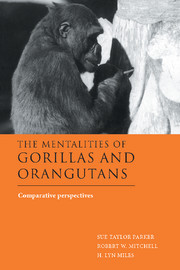Book contents
- Frontmatter
- Contents
- List of contributors
- Preface
- Acknowledgments
- I Comparative evolutionary and developmental perspectives on gorillas and orangutans
- II Cognition and tool use in gorillas and orangutans
- III Communication in gorillas and orangutans
- IV Social cognition in gorillas and orangutans
- 14 Comparative aspects of mirror self-recognition in great apes
- 15 Deception and concealment as strategic script violation in great apes and humans
- 16 Levels of imitation and cognitive mechanisms in orangutans
- 17 Parental encouragement in Gorilla in comparative perspective: implications for social cognition and the evolution of teaching
- 18 The development of social roles in the play of an infant gorilla and its relationship to sensorimotor intellectual development
- V Epilogue
- Index of authors
- Index of subjects
15 - Deception and concealment as strategic script violation in great apes and humans
Published online by Cambridge University Press: 20 October 2009
- Frontmatter
- Contents
- List of contributors
- Preface
- Acknowledgments
- I Comparative evolutionary and developmental perspectives on gorillas and orangutans
- II Cognition and tool use in gorillas and orangutans
- III Communication in gorillas and orangutans
- IV Social cognition in gorillas and orangutans
- 14 Comparative aspects of mirror self-recognition in great apes
- 15 Deception and concealment as strategic script violation in great apes and humans
- 16 Levels of imitation and cognitive mechanisms in orangutans
- 17 Parental encouragement in Gorilla in comparative perspective: implications for social cognition and the evolution of teaching
- 18 The development of social roles in the play of an infant gorilla and its relationship to sensorimotor intellectual development
- V Epilogue
- Index of authors
- Index of subjects
Summary
In his books Animal Intelligence and Mental Evolution in Animals, Romanes (1882/1906; 1884/1900) argued that apes, being phylogenetically close to humans, should be capable of intentional deception. Until recently, scientists have had little more than Romanes' faith and a few observations upon which to base an expectation of skill in intentional deception in apes (Mitchell, 1999). But in the past two decades, descriptions of deceptive behavior in apes and other nonhuman primates, as well as discussions of its psychological requisites, have become commonplace, lending greater support to the expectations of intentional deception by apes and of commonalities in the underlying mental states in humans and apes (see, e.g., Menzel, 1974; De Waal, 1982, 1986; Miles, 1986; Mitchell, 1986, 1993, 1997; Mitchell & Thompson, 1986a,c; Smith, 1987; Whiten & Byrne, 1988; Byrne & Whiten, 1990, 1992; Byrne, 1997). As might be expected on phylogenetic grounds, many deceptions used by humans in sports, play, and teasing (e.g., Mawby & Mitchell, 1986; Mitchell & Thompson, 1986b, 1993; LaFrenière, 1988; Leekam, 1991; Reddy, 1991; Mitchell, 1996) are strikingly similar to those used by nonhuman primates. Just as the signing skills of great apes are comparable to those of 2- to 3-year-old children (Brown, 1970; Savage-Rumbaugh et al., 1993; Miles, 1997; this volume; Parker & McKinney, in press), their deceptions are also sometimes similarly comparable (e.g., Reddy, 1991), but often great apes' deceptions seem much more skillful than those of even 4-year-old children (e.g., LaFrenière, 1988).
- Type
- Chapter
- Information
- The Mentalities of Gorillas and OrangutansComparative Perspectives, pp. 295 - 315Publisher: Cambridge University PressPrint publication year: 1999
- 6
- Cited by



